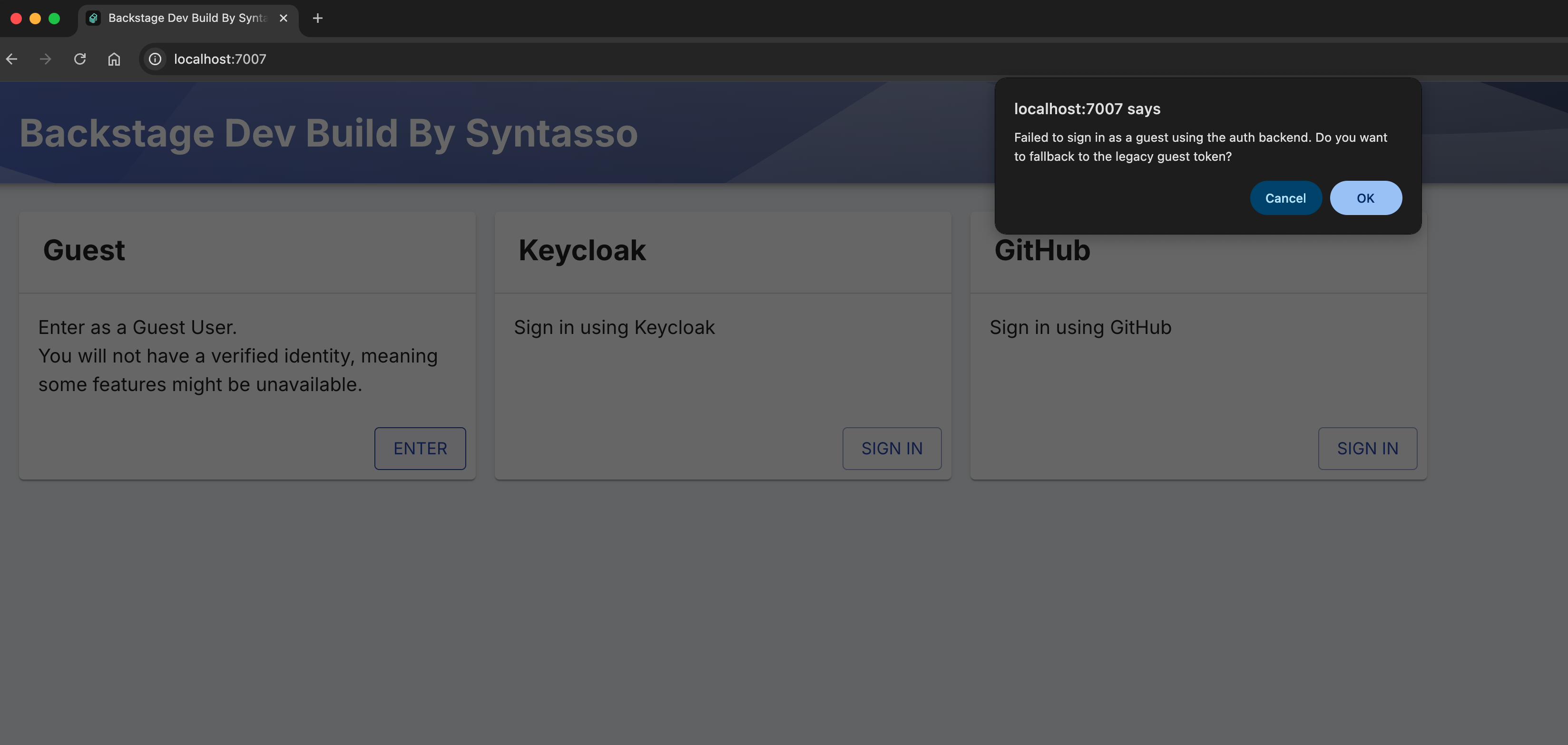NOT FOR PRODUCTION
This is a development image that is useful for getting started quickly in a development environment. It is not suitable for production use and should be used only for development and testing purposes.
Backstage Development Image
Overview
This guide walks you through deploying a development Backstage instance with Syntasso Kratix Enterprise (SKE) plugins pre-installed.
It is:
- ✅ Ideal for local testing and development
- 🚫 Not suitable for production environments or long term use
- ⚠️ Pre-packaged with fixed assumptions around Kubernetes and S3-compatible storage (not flexible or configurable)
For more advanced or production-ready customization, see the Configuring Backstage documentation.
Prerequisites
Before you begin, ensure you have:
- A running Kubernetes cluster
- Access to an S3-compatible bucket (e.g., MinIO, GCS, or S3)
Configuration
What You Need to Configure
Below is an example ConfigMap for Backstage that includes the necessary
configurations to run with Syntasso Kratix Enterprise. This needs to be modified to suit
your environment:
-
To modify to use your own Bucket update the
endpointandbucketNameinintegrations.awsS3andcatalog.providers.awsS3 -
By default Backstage is setup to be accessible via
kubectl port-forward. If you plan to expose Backstage by ingress or NodePort, make surebaseUrlandcors.originmatch your setup.
apiVersion: v1
kind: ConfigMap
metadata:
name: backstage
namespace: kratix-platform-system
data:
config: |
auth:
environment: development
providers:
guest: {}
app:
title: Backstage Dev Build By Syntasso
# OPTIONAL: If your using a different nodeport, modify the baseUrl to match the nodeport
# The default setting works with the Kratix quick start setup: https://docs.kratix.io/ske/installing-ske/preconfigured-install
baseUrl: http://localhost:31340
organization:
name: app-config
backend:
baseUrl: http://localhost:31340
listen:
port: 7007
host: 0.0.0.0
csp:
upgrade-insecure-requests: false
connect-src: ["'self'", "http:", "https:"]
cors:
origin: http://localhost:31340
methods: [GET, HEAD, PATCH, POST, PUT, DELETE]
credentials: true
database:
client: better-sqlite3
connection: ":memory:"
cache:
store: memory
auth:
dangerouslyDisableDefaultAuthPolicy: true
integrations:
awsS3:
# We will show how to configure the source of these environment variables later
- accessKeyId: ${AWS_ACCESS_KEY_ID}
secretAccessKey: ${AWS_SECRET_ACCESS_KEY}
# OPTIONAL: Modify to match the endpoint for your S3 compatible bucket.
# The default setting works with the Kratix quick start setup: https://docs.kratix.io/ske/installing-ske/preconfigured-install
endpoint: 'http://minio.kratix-platform-system.svc.cluster.local'
s3ForcePathStyle: true
techdocs:
builder: "local"
generator:
runIn: "docker"
publisher:
type: "local"
catalog:
import:
entityFilename: catalog-info.yaml
pullRequestBranchName: backstage-integration
rules:
- allow:
[Domain, Component, System, API, Resource, Location, Group, Template]
locations:
- type: file
target: ../../examples/template/template-ske.yaml
rules:
- allow: [Template]
- type: file
target: ../../examples/entities.yaml
rules:
- allow:
[
Domain,
Component,
System,
API,
Resource,
Location,
Group,
Template,
]
- type: file
target: ../../examples/org.yaml
rules:
- allow: [User, Group]
providers:
awsS3:
kratix-minio:
# OPTIONAL: Modify to match your bucket name and configuration.
# The default setting works with the Kratix quickstart setup: https://docs.kratix.io/ske/installing-ske/preconfigured-install
bucketName: kratix
prefix: backstage/
region: us-east-1
schedule:
frequency: { seconds: 10 }
timeout: { seconds: 20 }
kubernetes:
serviceLocatorMethod:
type: multiTenant
clusterLocatorMethods:
- type: config
clusters:
- url: "https://kubernetes.default.svc.cluster.local"
name: platform
authProvider: serviceAccount
serviceAccountToken: ${SA_TOKEN}
skipTLSVerify: true
ske:
kubernetes:
platformName: platform
Once you have modified the configuration, store it in a local file and create the ConfigMap in your Kubernetes cluster:
kubectl apply -f configmap.yaml
Installation
Once your ConfigMap is ready, all thats left is to deploy Backstage with the
provided manifest below. The manifest can be updated to:
-
Reference the Bucket secret
-
Any ingress modifications you may want to make, such as using as NodePort.
-
ClusterRole modifications if you want to limit what Backstage can access. It needs access to all Promises and all Promise APIs. By default it has cluster-wide access to all resources.
---
apiVersion: apps/v1
kind: Deployment
metadata:
labels:
app: backstage
name: backstage
namespace: kratix-platform-system
spec:
replicas: 1
selector:
matchLabels:
app: backstage
template:
metadata:
labels:
app: backstage
spec:
serviceAccountName: backstage
imagePullSecrets:
- name: syntasso-registry
containers:
- env:
- name: AWS_ACCESS_KEY_ID
valueFrom:
secretKeyRef:
# OPTIONAL: Modify to match the secret for access to your bucket.
# The default setting works with the Kratix quick start setup: https://docs.kratix.io/ske/installing-ske/preconfigured-install
name: minio-credentials
key: accessKeyID
- name: AWS_SECRET_ACCESS_KEY
valueFrom:
secretKeyRef:
# OPTIONAL: Modify to match the secret for access to your bucket.
# The default setting works with the Kratix quick start setup: https://docs.kratix.io/ske/installing-ske/preconfigured-install
name: minio-credentials
key: secretAccessKey
- name: SA_TOKEN
valueFrom:
secretKeyRef:
# Do not edit, this secret gets created within this manifest
name: backstage-token
key: token
image: registry.syntasso.io/syntasso/backstage-dev-build:latest
imagePullPolicy: IfNotPresent
name: backstage
ports:
- containerPort: 7007
protocol: TCP
resources: {}
terminationMessagePath: /dev/termination-log
terminationMessagePolicy: File
volumeMounts:
- mountPath: /config
name: config
dnsPolicy: ClusterFirst
restartPolicy: Always
schedulerName: default-scheduler
securityContext: {}
terminationGracePeriodSeconds: 30
volumes:
- configMap:
defaultMode: 420
items:
- key: config
path: app-config.yaml
name: backstage
name: config
---
apiVersion: v1
kind: Service
metadata:
name: backstage
namespace: kratix-platform-system
spec:
ports:
- port: 7007
protocol: TCP
selector:
app: backstage
---
apiVersion: rbac.authorization.k8s.io/v1
kind: ClusterRole
metadata:
name: backstage
rules:
# OPTIONAL: These are broad security settings, you can limit backstage permissions here.
- apiGroups: ["*"]
resources: ["*"]
verbs: ["*"]
---
apiVersion: rbac.authorization.k8s.io/v1
kind: ClusterRoleBinding
metadata:
name: backstage
roleRef:
apiGroup: rbac.authorization.k8s.io
kind: ClusterRole
name: backstage
subjects:
- kind: ServiceAccount
name: backstage
namespace: kratix-platform-system
---
apiVersion: v1
kind: ServiceAccount
metadata:
name: backstage
namespace: kratix-platform-system
---
apiVersion: v1
kind: Secret
metadata:
name: backstage-token
namespace: kratix-platform-system
annotations:
kubernetes.io/service-account.name: backstage
type: kubernetes.io/service-account-token
Once modified and saved, apply the manifest to your cluster:
kubectl apply -f backstage.yaml
Accessing Backstage
-
If using NodePort or Ingress, visit your corresponding address, e.g:
http://localhost:31340 -
If using port-forwarding, run the following command in your terminal:
kubectl port-forward service/backstage -n kratix-platform-system 7007:7007
Then navigate to: http://localhost:7007. You can login using the legacy guest token method by click ok on the pop up when selecting the Guest login method.

Next Steps
Now that Backstage is running:
- Follow the Backstage Destination documentation to configure Kratix to manage the component and template configuration.
- Use and configure automatic access to your Promises in Backstage.
